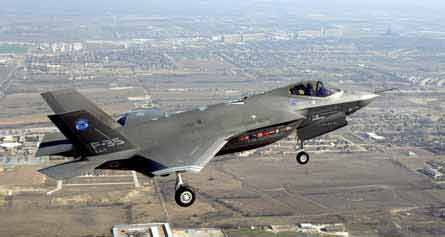Maiden flight cut short by sensor anomaly, but chief pilot praises F-35's controllability and responsiveness of engine
Lockheed Martin expects to get its first F-35 Joint Strike Fighter back in the air early this month after resolving the sensor anomaly that curtailed its 15 December maiden flight. Despite being required by mission rules to return after 35min because of an air-data sensor "miscomparison", F-35 chief pilot Jon Beesley says the aircraft exceeded expectations in several areas.
"Handling qualities are about like we thought, but roll rate was a little faster," says Beesley, who adds that the F-35 "flies like a smaller, quicker [F-22] Raptor". After lift-off from the Fort Worth, Texas runway, the climb-out angle on military power was steeper than expected, he says, praising the controllability of the aircraft and responsiveness of its Pratt & Whitney F135 engin
|
|---|
The F-35 "flies like a smaller, quicker Raptor", said chief pilot Jon Beesley after its debut flight from Fort Worth |
New-technology systems in the F-35, including the electro-hydraulic flight-control actuators and integrated auxiliary/emergency power and environmental control package, worked as expected, Beesley says. Inertial flight-control sensors, which back up the navigation system, worked well, but the air-data anomaly cut short the flight before the gear could be cycled, restricting airspeed to 225kt and altitude to 15,000ft.
The sensor problem caused by the left angle-of-attack (AoA) vane being calibrated low, combined with too much friction in the right vane. The right vane is being replaced and the sensors re-calibrated and tested during high-speed taxi runs before the first F-35 will return to flight, says air-vehicle team member J D McFarlan.
Lockheed plans to fly the first F-35 for "the next couple of months" before deciding whether to conduct proof-load testing as originally planned, says Doug Pearson, vice-president, F-35 integrated test force. The alternative being considered is to clear the aircraft for an expanded envelope by analysis of the flight-test data, avoiding a lengthy grounding for proof testing.
Flight testing of AA-1 is planned to last 24 months, with the aircraft being relocated to the US Air Force test centre at Edwards AFB in California after 18 months - six months before the arrival of AF-1, the first optimised conventional take-off and landing F-35A - to act as a pathfinder for standing up the test team.
The next JSF to fly is planned to be BF-1, the first short take-off and landing F-35B, with its maiden flight scheduled for mid-2008.
Source: Flight International




















